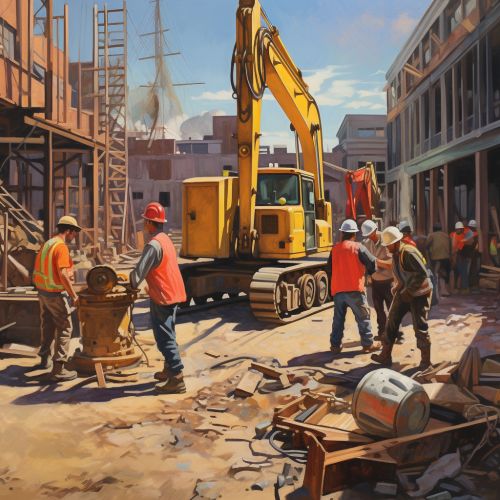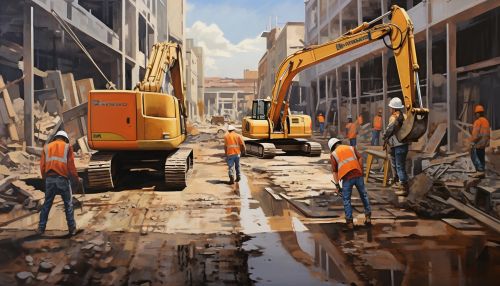Construction
Introduction
Construction is a broad term that refers to the process of constructing buildings or infrastructure. It involves the conversion of raw materials into finished structures through a series of stages, including planning, design, site preparation, and actual construction. The field of construction is vast and diverse, encompassing a wide range of specialized disciplines such as civil engineering, architecture, and project management.
History of Construction
The history of construction spans many millennia, from the earliest human-made structures to the complex, high-tech buildings of today. Early construction methods were simple, using raw materials like stone, wood, and mud. The advent of agriculture led to the development of permanent settlements and the construction of more complex structures, such as granaries and houses.
The ancient civilizations of Egypt, Greece, and Rome made significant advancements in construction technology. They developed techniques for building large, complex structures such as pyramids, temples, and aqueducts. These civilizations also introduced the use of more durable materials like brick and concrete.
The Middle Ages saw the construction of grand cathedrals and castles, while the Industrial Revolution brought about significant changes in construction methods and materials. The invention of steel and the development of new construction techniques allowed for the construction of taller, more durable buildings.
In the 20th century, advances in technology and engineering led to the development of new construction methods and materials, such as reinforced concrete and steel framing. These advancements have made it possible to construct increasingly complex and sophisticated structures.
Types of Construction
Construction can be broadly divided into three main types: buildings, infrastructure, and industrial.
Building construction involves the creation of structures that provide shelter, such as houses, apartments, schools, and office buildings. This type of construction can be further divided into residential and non-residential construction.
Infrastructure construction, also known as heavy civil or heavy engineering, involves the construction of large-scale public works like bridges, highways, railways, airports, and dams.
Industrial construction involves the construction of factories, power plants, and other large-scale industrial facilities. This type of construction often requires specialized skills and equipment.
Construction Processes
Construction involves a series of processes, from initial planning and design to final completion. These processes can be broadly divided into four main stages: planning, design, construction, and operation.
Planning involves determining the feasibility of a construction project, including cost estimates, scheduling, and resource allocation. This stage also involves obtaining necessary permits and approvals.
Design involves creating detailed plans and specifications for the construction project. This can include architectural drawings, structural calculations, and other technical documents.
Construction is the actual building process, where the plans and specifications are turned into a physical structure. This stage involves a variety of activities, including site preparation, foundation work, framing, and finishing.
Operation involves the use and maintenance of the completed structure. This can include routine maintenance, repairs, and renovations.
Construction Materials
A wide variety of materials are used in construction, each with its own properties and uses. These include traditional materials like wood, stone, and brick, as well as modern materials like concrete, steel, and glass.
Wood is a versatile material that has been used in construction for thousands of years. It is strong, lightweight, and easy to work with, making it a popular choice for many types of construction.
Stone is a durable material that has been used in construction since ancient times. It is often used for foundations, walls, and decorative elements.
Brick is a man-made material that has been used in construction for thousands of years. It is durable, fire-resistant, and provides good insulation.
Concrete is a composite material made from cement, aggregate, and water. It is strong, durable, and versatile, making it a popular choice for many types of construction.
Steel is a strong, durable material that is often used in the construction of large, high-rise buildings. It is also used in the construction of bridges, tunnels, and other large structures.
Glass is a versatile material that is often used in the construction of windows, doors, and other architectural elements. It provides natural light and can be used to create a variety of aesthetic effects.
Construction Equipment
Construction requires a wide range of equipment, from hand tools to heavy machinery. This equipment is used for a variety of tasks, including excavation, lifting, transporting, and finishing.
Excavators are large machines used for digging and moving large amounts of earth. They are often used in the initial stages of construction to prepare the site for building.
Cranes are used to lift and move heavy materials and equipment. They are essential for the construction of high-rise buildings and other large structures.
Loaders are used to move and load materials onto other equipment or vehicles. They are often used in conjunction with excavators and cranes.
Concrete mixers are used to mix concrete on-site. They are essential for any construction project that involves the use of concrete.
Power tools are used for a variety of tasks, including drilling, cutting, and fastening. They are essential for many aspects of construction, from framing to finishing.
Construction Safety
Safety is a critical concern in the construction industry. Construction sites can be dangerous places, with risks of falls, accidents with machinery, and exposure to hazardous materials.
Regulations are in place to ensure the safety of workers on construction sites. These regulations cover a wide range of issues, from the use of personal protective equipment to the safe operation of machinery.
Training is also an important aspect of construction safety. Workers are trained in safe work practices and procedures, and are required to follow these at all times.
Equipment is used to protect workers from injury. This can include hard hats, safety glasses, high-visibility clothing, and safety harnesses.
Inspections are carried out regularly to ensure that safety regulations are being followed and that equipment is in good working order.
Future of Construction
The future of construction is likely to be shaped by advances in technology and changes in societal needs. This could include the increased use of sustainable materials and construction methods, the development of smart buildings, and the use of automation and robotics in construction.
Sustainable construction involves the use of environmentally friendly materials and construction methods. This could include the use of recycled materials, energy-efficient designs, and low-impact construction techniques.
Smart buildings use technology to improve efficiency and comfort. This could include the use of sensors and automation to control heating, lighting, and security systems.
Robotics could play a significant role in the future of construction. Robots could be used for a variety of tasks, from bricklaying to surveying, potentially improving efficiency and safety.
See Also
Architecture Civil Engineering Project Management
Categories


